Gum treatment - Periodontics
The term periodontitis describes inflammation of the periodont, the tissue that surrounds and supports the teeth in the jaws. Similar to tooth decay, specific bacteria are responsible for periodontitis. The disease is often not noticed by those affected, since they can be completely free of pain for long periods of time. Eventually bleeding, receding gums or bad breath will be noticed. The inflammation eventually leads to the degeneration of the jawbone, which can lead to loosening of the teeth or even tooth loss. Periodontal disease is a leading cause of tooth loss in older people - even more common than tooth decay. Periodontal disease not only has implications in the mouth, it is a general health risk factor, for example, in heart disease and diabetes. If we detect periodontal disease during the examination, we perform an accurate diagnosis in order to determine the severity of the disease. The diagnosis includes x-rays, measuring the gum pockets and, if necessary, microbiological tests to determine which bacteria have caused the disease. Periodontitis is a chronic disease and requires long-term care and a coordinated treatment approach. Depending upon the severity of periodontitis, the treatment process is divided into the following steps:
Pre-treatment
The pre-treatment is used to establish the necessary conditions for the therapy. First plaque and tartar are removed through professional dental cleaning, resulting in the inflammation being contained and the number of bacteria reduced. An important factor for the success of the treatment is long-term good oral hygiene. We discuss with you what you need to optimize your oral hygiene at home.
Minimal invasive treatment
Minimal invasive treatment is all that is necessary for many forms of periodontal disease. In this case surgery is not necessary. Using special instruments, the gum pockets are thoroughly cleaned under local anesthesia. Hard and soft plaque that adhere to the tooth or root beneath the gums are removed and the bacterial film destroyed. In our practice we use state-of-the-art equipment for cleaning (ultrasonic and air flow / powder jet equipment). After cleaning the gum pockets are flushed with an anti-bacterial medication. In severe forms of periodontitis it may be necessary to carry out concurrent antibiotic therapy during the treatment.
Further information can be found in the scientific opinions of the German Society for Dental, Oral and Maxillofacial Medicine (DGZMK):
- Adjuvant antibiotic therapy in periodontitis
- Microbiological diagnostics in periodontal therapy
- Sonic and ultrasonic scalers in periodontal therapy
Surgical treatment
Surgical treatment may be necessary with highly advanced periodontitis where the gums have very deep pockets or the minimal invasive therapy has been unsuccessful. By loosening the gum line, the gum pocket can be examined and diseased tissue completely removed. The surgical treatment also provides advantages in that targeted measures can reduce the after-effects of periodontitis, such as bone loss. In this way long-term tooth retention is significantly improved.
Recall / aftercare
Periodontitis is a chronic disease and requires continuous care and control. Optimal oral hygiene at home is very important. In the course of the treatment we will show you which dental care aids are suitable. The importance of regular dental inspections cannot be over emphasized so that problem areas can be identified early and, if necessary, retreated. Regular professional teeth cleaning also stabilizes the results achieved by the treatment. Depending on the severity of the disease, two to four follow-up appointments a year are required. In our practice we use a special recall system that will automatically remind you of your next appointment.






